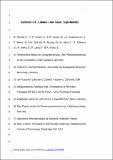| dc.contributor.author | Patzold, M. | |
| dc.contributor.author | Andert, T. P. | |
| dc.contributor.author | Asmar, S. W. | |
| dc.contributor.author | Anderson, J. D. | |
| dc.contributor.author | Barriot, J.- P. | |
| dc.contributor.author | Bird, M. K. | |
| dc.contributor.author | Hausler, B. | |
| dc.contributor.author | Hahn, M. | |
| dc.contributor.author | Tellmann, S. | |
| dc.contributor.author | Sierks, H. | |
| dc.contributor.author | Lamy, P. | |
| dc.contributor.author | Weiss, Benjamin P. | |
| dc.date.accessioned | 2016-08-17T18:14:27Z | |
| dc.date.available | 2016-08-17T18:14:27Z | |
| dc.date.issued | 2011-10 | |
| dc.identifier.issn | 0036-8075 | |
| dc.identifier.issn | 1095-9203 | |
| dc.identifier.uri | http://hdl.handle.net/1721.1/103947 | |
| dc.description.abstract | Asteroid 21 Lutetia was approached by the Rosetta spacecraft on 10 July 2010. The additional Doppler shift of the spacecraft radio signals imposed by 21 Lutetia’s gravitational perturbation on the flyby trajectory were used to determine the mass of the asteroid. Calibrating and correcting for all Doppler contributions not associated with Lutetia, a least-squares fit to the residual frequency observations from 4 hours before to 6 hours after closest approach yields a mass of (1.700 ± 0.017) × 1018 kilograms. Using the volume model of Lutetia determined by the Rosetta Optical, Spectroscopic, and Infrared Remote Imaging System (OSIRIS) camera, the bulk density, an important parameter for clues to its composition and interior, is (3.4 ± 0.3) × 103 kilograms per cubic meter. | en_US |
| dc.description.sponsorship | German Aerospace Center (DLR) (grant 50QM1002) | en_US |
| dc.description.sponsorship | German Aerospace Center (DLR) (grant 50QM1004) | en_US |
| dc.description.sponsorship | United States. National Aeronautics and Space Administration | en_US |
| dc.language.iso | en_US | |
| dc.publisher | American Association for the Advancement of Science (AAAS) | en_US |
| dc.relation.isversionof | http://dx.doi.org/10.1126/science.1209389 | en_US |
| dc.rights | Creative Commons Attribution-Noncommercial-Share Alike | en_US |
| dc.rights.uri | http://creativecommons.org/licenses/by-nc-sa/4.0/ | en_US |
| dc.source | Prof. Weiss via Michael Noga | en_US |
| dc.title | Asteroid 21 Lutetia: Low Mass, High Density | en_US |
| dc.type | Article | en_US |
| dc.identifier.citation | Patzold, M., T. P. Andert, S. W. Asmar, J. D. Anderson, J.- P. Barriot, M. K. Bird, B. Hausler, et al. “Asteroid 21 Lutetia: Low Mass, High Density.” Science 334, no. 6055 (October 27, 2011): 491–492. | en_US |
| dc.contributor.department | Massachusetts Institute of Technology. Department of Earth, Atmospheric, and Planetary Sciences | en_US |
| dc.contributor.approver | Weiss, Benjamin P. | en_US |
| dc.contributor.mitauthor | Weiss, Benjamin P. | en_US |
| dc.relation.journal | Science | en_US |
| dc.eprint.version | Author's final manuscript | en_US |
| dc.type.uri | http://purl.org/eprint/type/JournalArticle | en_US |
| eprint.status | http://purl.org/eprint/status/PeerReviewed | en_US |
| dspace.embargo.terms | N | en_US |
| dc.identifier.orcid | https://orcid.org/0000-0003-3113-3415 | |
| mit.license | OPEN_ACCESS_POLICY | en_US |
| mit.metadata.status | Complete | |
